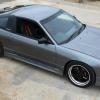More Digital Photography Tips - Post Processing
Announcements
-
Similar Content
-
Latest Posts
-
Shit thing to find eh? I guess the big issue is that whatever "fix" you do now, it might slow the rust down but won't fix it. I just wanted to add that in no way is fixing sheet metal in 3 dimensions the place to start with welding....that is a pro only job because its too hard to work out where things should be, let alone doing a clean enough job that it can look OK and still be strong too. I needed to get a new rear quarter panel on the GTR and it took a pro weeks to get the old one off cleanly, new one on in the right place and looking somewhat like it should have with most of the previous connecting panels in place. Gluing a couple of bits of metal together with a welder in the garage is doable, but that is totally different to doing panel replacement
-
This seems to be a very popular swap since all the turbo skyline prices went through the roof! I'll let someone more familiar chime in, but I understand that yes you probably want to swap the loom in to swap out the auto TCM stuff. You should not assume everything just plugs in either, you need to check at least the ECU wiring diagram for any differences at the plug at the left headlight and probably the ones near the ECU that join the dash loom too
-
By dingleberry · Posted
hows it fellas, my first post here which seems crazy cos half the forums i read are like the same age as me haha. to make a long story short ive got an r34 sedan (rb25de neo auto) which im swapping to a s0/s1? rb25det, r33 big box and nismo gt pro lsd. i have the motor and gearbox all bolted up outside the car, old motor and trans out. i bought the motor with stock ecu and loom, do i switch over to that? or will it be easier to get a r34 manual ecu and keep the loom if thats even possible. also engine mounts look different, anything else thats different or incompatible? cheers, hope this all makes sense Paddy -
att.4QNbuJlz_gNZPFBGFqeEvxSUHXkGt7z40V59MrtXTPg.mp4
-
Plan on the day will be to park trackside. Depending on space availability we will try put a small shade tent and a few of the cars on top of the hill inside turn 3, this is an easy to get to parking area with views of Turn 2, Turn 3, Turn 4 and Turn 5 and limited other pieces of the view around the track. IMPORTANT NOTE! One consideration from previous years is from memory the trackside parking sells out before the admission tickets, for that reason I encourage anyone planning on coming to buy tickets for parking now via the official website; https://www.worldtimeattack.com/ The type of parking you are looking for is 2 Day Park & View (Access Around Venue) Vehicle Pass Only Please note this does not include admission to the event itself, remember to grab that also, and kids under 12 get in for free!
-







Recommended Posts
Create an account or sign in to comment
You need to be a member in order to leave a comment
Create an account
Sign up for a new account in our community. It's easy!
Register a new accountSign in
Already have an account? Sign in here.
Sign In Now